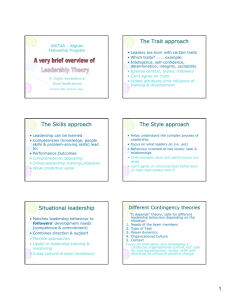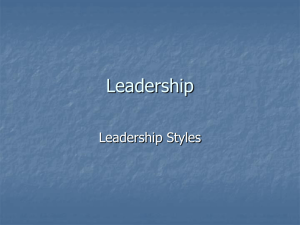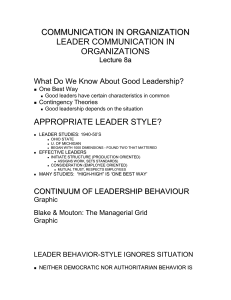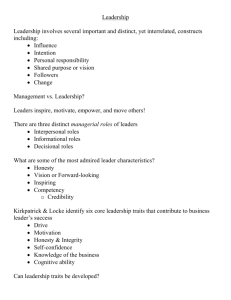Chapter Ten
advertisement
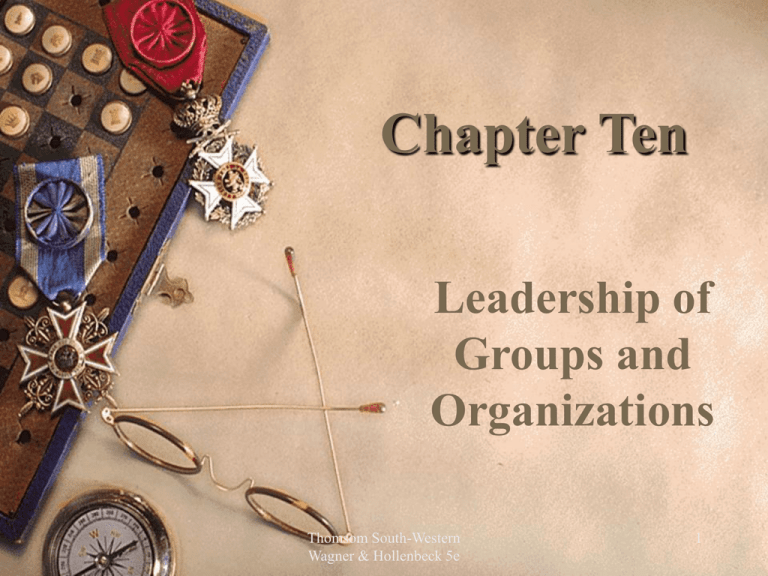
Chapter Ten Leadership of Groups and Organizations Thomsom South-Western Wagner & Hollenbeck 5e 1 Chapter Overview This chapter examines the following topics: – The Integrated Leadership Model – Universal Approaches to Leadership • Leader Traits • • • • Leader Decision-Making Styles Leader Behaviors Transformational Leadership Leader Irrelevance – Characteristics of Followers and Situations • • • • The Leadership Motivation Pattern Vertical Dyad Linkage Life-Cycle Model Substitutes for Leadership – Comprehensive Theories of Leadership • Fiedler’s Contingency Theory • Vroom-Yetton Decision Tree Model • Path-Goal Theory – The Integrated Leadership Model Revisited 2 Introduction Leadership is the force that energizes and directs groups Given the centrality of leadership to the behavior of people in groups and to organizational achievement, it is important to understand how leaders emerge and what qualities make them effective 3 The Integrated Leadership Model Most people have a difficult time expressing exactly what the word leadership means One characteristic shared by people that are classed as strong leaders is the ability to influence others A leader’s influence must be sanctioned by followers A complete definition of leadership must describe the context in which leadership occurs and the symbolism captured by the leader For the purposes here, leadership will be defined as the use of noncoercive and symbolic influence to direct and coordinate the activities of the members of an organized group toward the accomplishment of group objectives 4 The Integrated Leadership Model In defining leadership, it is important to distinguish between leaders and managers According to Mintzberg, leadership deals explicitly with guiding and motivating employees Edward Hollander has suggested that the leadership process is best understood as the occurrence of mutually satisfying interactions among leaders and followers within a particular situational context – The locus of leadership appears where the forces of leaders, followers, and situations come together 5 Universal Approaches to Leadership Not all theories about leadership emphasize the three-dimensional character of the leadership process as proposed by Hollander Universal theories emphasize the traits and abilities, typical behaviors, and decisionmaking styles that make leaders different from nonleaders 6 Leader Traits Leader Decision-Making Styles The earliest approaches to leadership held that leaders were born not made Large-scale research projects suggest that the perceived amount of time and energy that the leader devotes to the job is a major determinant of ratings of leader effectiveness General cognitive ability seems to be one of the best overall predictors of leadership ability Specific technical skills and knowledge about a group’s task also show modest relationships with success in leadership The weak relationship with personal traits prompted research in this area Three decision-making styles have been examined: – Authoritarian leader: makes virtually all decisions by himself or herself – Democratic leader: works with the group to help members come to their own decisions – Laissez-faire leader: leaves the group alone to do whatever it wants Results of studies suggest that most groups prefer a democratic leader Studies revealed modest correlations between leader style and follower behavior 7 Leader Behaviors Researchers have concluded that two general classes of supervisory behavior exist: – Employee-oriented behavior: aims to meet the social and emotional needs of group members – Job-oriented behavior: focuses on careful supervision of employees’ work methods and task accomplishment Researchers also concluded that most supervisory behaviors could be assigned to one of two dimensions: – Consideration structure: closely resembles the employeecentered orientation – Initiating structure: resembles the job-centered orientation Blake and Mouton developed the notion of the managerial grid, proposing that a leader needs to rate highly in terms of both concern of people and production to be truly effective 8 Transformational Leadership The theories of transformational leadership emphasizes the ability of the leader to communicate new visions of an organization to followers Transformational leaders can be characterized by their: – Traits: often called charismatic leaders – Behaviors: raise follower's awareness – Decision-making styles: often autocratic, but are experts at getting subordinates to commit 9 Leader Irrelevance Advocates of leader irrelevance, a situation-based approach to understanding leadership, emphasize that situations are much more important determinants of events than leader characteristics for several reasons: – Factors outside the leader’s control tend to affect profits and other critical elements more than anything a leader might do – Leaders at relatively high levels tend to have unilateral control over only a few resources – The selection process filters people such that those in leadership positions tend to act in similar ways 10 Characteristics of Followers and Situations: The Leadership Motivation Pattern The theory behind the leadership motivation pattern (LMP), an early interaction theory, grew out of David McClelland’s research on characteristics of the leader This theory focuses on the interaction between the traits of the leader and the characteristics of the situation The leadership motivation pattern is a composite of three specific characteristics: – A high need for power – A low need for affiliation with others – A high degree of self-control 11 Characteristics of Followers and Situations: The Leadership Motivation Pattern McClelland suggested that two types of leadership situations exist: – Entrepreneurial situation: occurs in small organizations or in small technical units in large organizations where a few key people do most of the work themselves – Bureaucratic situation: found in the context of large, formalized, tightly structured organizations Findings strongly suggest that the effect of a set of leader characteristics on a leader’s success depends on the situation in which the leader is performing 12 Vertical Dyad Linkage An approach to leadership that emphasizes the characteristics of followers is the vertical dyad linkage This approach places more emphasis on leader behaviors A vertical dyad consists of two persons who are linked hierarchically This approach suggests that leaders tend to classify subordinates as either in-group members, those who are willing and able to do more than the task outlined in a formal job description, or out-group members, those who will not or cannot expand their roles beyond formal requirements 13 Life-Cycle Model According to the life-cycle model developed by Paul Hersey and Kenneth Blanchard, the effectiveness of a leader’s decision-making style depends largely on followers’ level of maturity, job experience, and emotional maturity This model proposes two basic dimensions on which decision-making style may vary: task orientation and relationship orientation The model suggests these two dimensions combine to form four distinct types of decision styles: telling, selling,participating, and delegating According to Hersey and Blanchard, the type of decision-making style that a leader should adopt depends on the level of maturity of the followers 14 Substitutes for Leadership The substitutes for leadership theory emphasizes leader behaviors and the situation One review of the scientific literature on this topic suggests that the most powerful substitutes for leadership relate to both characteristics of the task and the organization as a whole 15 Comprehensive Theories of Leadership The comprehensive leadership theory deals with all three forces (leader, follower,situation) simultaneously Each of the three comprehensive theories differ only in that each tends to focus on a particular leader characteristic, either a personal characteristic, a behavioral orientation, or a decision-making style 16 Fiedler’s Contingency Theory The leader’s orientation toward either task or relationships is the central piece of this complex and controversial theory of leadership that was proposed by Fred Fiedler This model is called a contingency theory because it holds the effectiveness of a leader depends on both the followers and the situation A leadership situation can be placed along a continuum of favorability depending on three factors: – Leader-follower relations: followers trust and respect the leader – Task structure: the group has clear goals and clear means of achieving them – Position power: ability to reward or punish subordinates for their behavior 17 Vroom-Yetton Decision Tree Model The decision tree model of leadership developed by Victor Vroom emphasizes the fact the leaders achieve success through effective decision making Vroom’s model recognizes four general styles of leadership: – Authoritarian – Consultive – Delegation – Group-based These are then broken down into seven specific decision styles – Three that are appropriate to both individual and group decisions – Two that are appropriate only to decisions involving individual followers – Two that are appropriate only to decisions that involve an entire group of followers The decision tree model proposes that the most effective leadership style depends on the characteristics of both the situation and the followers 18 Path-Goal Theory The most comprehensive This approach is based theory of leadership to date on the expectancy theory and the theory that best of motivation and exemplifies all aspects of emphasizes the three the transactional model is motivational variables the path-goal theory of that leaders may leadership influence through their behaviors or decision At the heart of this theory making styles: is the notion that the – Valences leader’s primary purpose – Instrumentalities is to motivate followers by – Expectancies clarifying goals and identifying the best paths to achieve those goals 19 Path-Goal Theory The job of the leader, according to this theory, is to manipulate these three factors in desirable ways This theory proposes that four behavioral styles can enable leaders to manipulate the three motivational variables: – – – – Directive Supportive Participative Achievement-oriented Because of the complexity of this theory, no one has yet undertaken a comprehensive study that tests every variable The framework provided by this theory is an excellent one for generating, testing, and understanding the complexities of the leadership process 20 The Integrated Leadership Model Revisited The first key to applying this model to your own leadership situation is to engage in self-assessment to learn your standing on several traits The second key is to make a critical assessment of those people who are following you to determine the degree of match between their characteristics and yours The third key is that leaders need to study the situation they are in to determine what kinds of leadership will be most effective with this specific configuration of followers and situation 21
